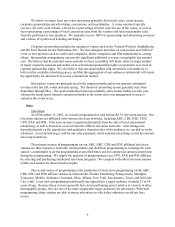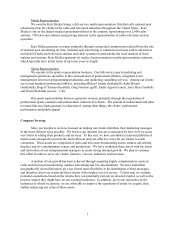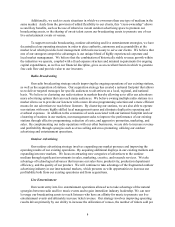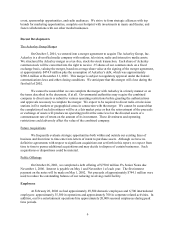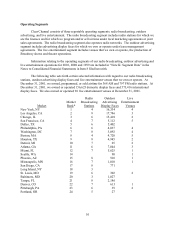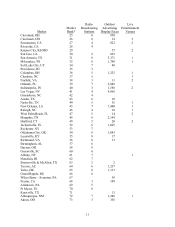iHeartMedia 2001 Annual Report Download - page 16
Download and view the complete annual report
Please find page 16 of the 2001 iHeartMedia annual report below. You can navigate through the pages in the report by either clicking on the pages listed below, or by using the keyword search tool below to find specific information within the annual report.
16
Although in the vast majority of cases broadcast licenses are renewed by the FCC even when
petitions to deny or informal objections are filed, there can be no assurance that any of our stations’
licenses will be renewed at the expiration of their terms.
Current Multiple Ownership Restrictions
The FCC has promulgated rules that, among other things, limit the ability of individuals and
entities to own or have an “attributable interest” in broadcast stations and other specified mass media
entities.
The 1996 Act mandated significant revisions to the radio and television ownership rules. With
respect to radio licensees, the 1996 Act directed the FCC to eliminate the national ownership restriction,
allowing one entity to own nationally any number of AM or FM broadcast stations. Other FCC rules
mandated by the 1996 Act greatly eased local radio ownership restrictions. The maximum allowable
number of radio stations that may be commonly owned in a market varies depending on the total number
of radio stations in that market, as determined using a method prescribed by the FCC. In markets with 45
or more stations, one company may own, operate, or control eight stations, with no more than five in any
one service (AM or FM). In markets with 30-44 stations, one company may own seven stations, with no
more than four in any one service; in markets with 15-29 stations, one entity may own six stations, with
no more than four in any one service. In markets with 14 stations or less, one company may own up to
five stations or 50% of all of the stations, whichever is less, with no more than three in any one service.
These new rules permit common ownership of substantially more stations in the same market than did the
FCC’s prior rules, which at most allowed ownership of no more than two AM stations and two FM
stations even in the largest markets.
Irrespective of FCC rules governing radio ownership, however, the Antitrust Division of the
United States Department of Justice and the Federal Trade Commission have the authority to determine
that a particular transaction presents antitrust concerns. Following the passage of the 1996 Act, the
Antitrust Division has become more aggressive in reviewing proposed acquisitions of radio stations,
particularly in instances where the proposed purchaser already owns one or more radio stations in a
particular market and seeks to acquire additional radio stations in the same market. The Antitrust
Division has, in some cases, obtained consent decrees requiring radio station divestitures in a particular
market based on allegations that acquisitions would lead to unacceptable concentration levels. The FCC
has also been more aggressive in independently examining issues of market concentration when
considering radio station acquisitions. The FCC has delayed its approval of numerous proposed radio
station purchases by various parties because of market concentration concerns, and generally will not
approve radio acquisitions when the Antitrust Division has expressed concentration concerns, even if the
acquisition complies with the FCC’s numerical station limits. Moreover, in recent years the FCC has
followed a so-called “flagging” policy under which it gives specific public notice of its intention to
conduct additional ownership concentration analysis, and solicits public comment on “the issue of
concentration and its effect on competition and diversity,” with respect to certain applications for consent
to radio station acquisitions based on estimated advertising revenue shares or other criteria.
With respect to television, the 1996 Act directed the FCC to eliminate the then-existing 12-
station national limit for station ownership and increase the national audience reach limitation from 25%
to 35%. The 1996 Act left local TV ownership restrictions in place pending further FCC review, and in
August 1999 the FCC completed this review and modified its local television ownership rule. Under the
current rule, permissible common ownership of television stations is dictated by Nielsen Designated
Market Areas, or “DMAs.” A company may own two television stations in a DMA if the stations’ Grade
B contours do not overlap. Conversely, a company may own television stations in separate DMAs even if


